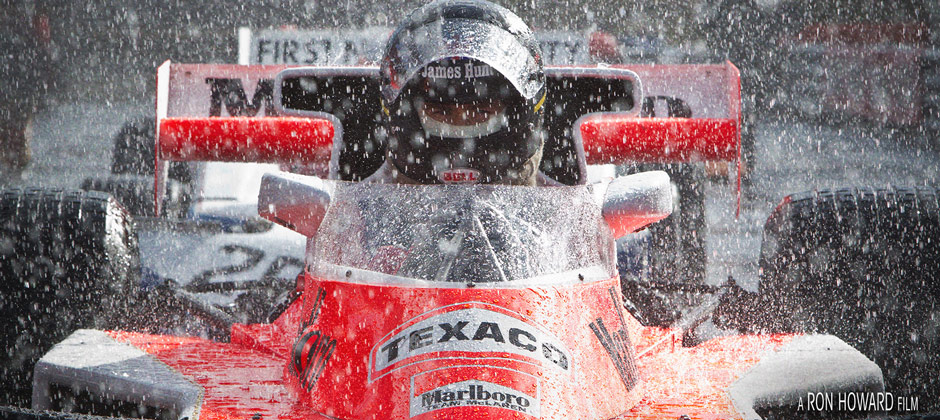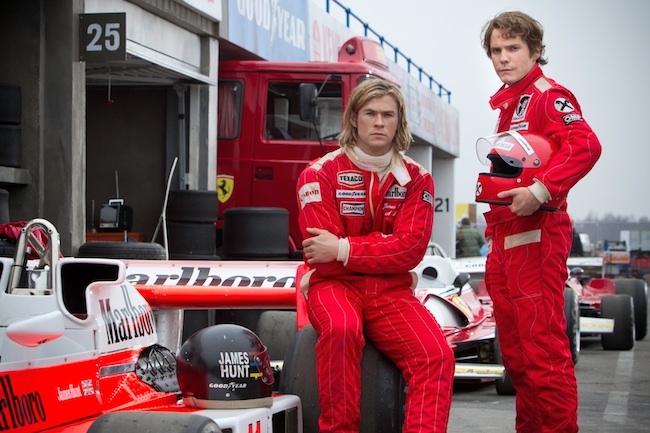Rush (2013)
CAST: Chris Hemsworth, Daniel Brühl
REVIEW:
Ron Howard was once on a roll as a highly-regarded filmmaker with films like Apollo 13 and the Oscar-winning A Beautiful Mind, but his star has lost a little of its luster in recent years. Reteaming with screenwriter Peter Morgan (Frost/Nixon), Howard has struck out for something a little different, with an entry in the sports movie genre that’s a little more gritty and a little more adult than some of the “wholesome” territory he’s well-traversed, with the true story of an infamous rivalry. To that end, Rush is an engaging sports drama whose central focus is not on the championships, but on the starkly-contrasting characters of two very different men.
The film chronicles events from 1970 to 1976, focusing on the intense rivalry between two highly skilled race car drivers, British playboy James Hunt (Chris Hemsworth) and Austrian perfectionist Niki Lauda (Daniel Brühl), which carries all the way from their first encounter in a lower-level racing competition until both men break into the big time, but the lion’s share of the runtime centers on the 1976 Formula One season, when their competition reaches its pinnacle. Both men have personal and professional setbacks. Hunt loses his wheels when his sponsor runs out of money, and falls into a downward spiral of booze and drugs and is dumped by his wife before finding his way back. Despite his own misgivings about safety issues and adverse weather conditions, Lauda participates in a dangerous race against his better judgment because he can’t stand the thought of losing face to Hunt. When he crashes and burns in a fiery car accident that leaves him badly burned and clinging to life, his qualms are justified. But as he lies recovering in a hospital bed, watching Hunt rack up victories that Lauda feels rightfully belong to him, the rivalry that indirectly caused his disfiguring accident also gives him the motivation to make a comeback.
Lauda’s accident is foreshadowed in the opening prologue in 1976, before we skip back six years earlier to show what led up to this point. The movie kicks right off with the sobering information that twenty-five drivers start every season in Formula One, and each year two of them die (at least in the 1970s when safety regulations were more lax). In many sports movies, there’s one clear “hero” we’re meant to root for, along with a clear “villain” or at least antagonist, but here we cut evenly back-and-forth between both men and gain a rooting interest in both of them. The movie takes the time to develop the starkly-contrasting personalities of the two men, and both are warts-and-all portrayals. Both are from wealthy, upper-class families and estranged themselves from them by forsaking the family business and pursuing their racing ambitions, but the similarities end there. Hunt is a cocky, flamboyant party boy who indulges voracious sexual appetites, while his polar opposite Lauda is cold, calculating, methodical, and abrasively anti-social. If Hunt overindulges in life’s pleasures, then Lauda goes to the opposite extreme, barely able to enjoy his honeymoon before worrying about his new marriage distracting him from his single-minded focus on the race track (“happiness is the enemy,” he states, “suddenly you have something to lose”). But we also see more human sides of both men; it’s implied that Hunt’s bravado covers anxieties (his cocksure demeanor is belied by his habit of vomiting before each race), and Lauda shows a rare more playful side when he takes his soon-to-be girlfriend and two starstruck fans on a wild ride through the Italian countryside. We follow both men’s personal lives away from the race track, including Hunt’s hasty marriage to model Suzy Miller (a blond Olivia Wilde), who later infamously leaves him for actor Richard Burton, and Lauda’s relationship with German socialite Marlene Knaus (Alexandra Maria Lara), the ex-girlfriend of actor Curt Jürgens.
Arguably more the central focus than the racing championship itself is the dynamic between the two men. It’s made clear that neither would have been as successful without having the other there to push him (“I need you busting my balls”, Lauda admits late in the movie). Calling them “frenemies” might be stretching it, but despite their extreme personality differences and the sometimes heated intensity of their rivalry, there’s a grudging respect and perhaps even a fondness. An enraged Hunt delivers a brutal beating to a reporter who asks an insensitive question about Lauda’s looks after his disfiguring car accident. The movie begins and ends with Lauda flipping Hunt the middle finger, but while the first time is in earnest anger (after their first race, in which Hunt runs Lauda off the track in a risky maneuver that could have caused an accident) the final time is obviously with tongue-in-cheek affection. After Hunt’s death of a heart attack in 1993, long after his retirement from his racing days, Lauda movingly admits that, despite their infamous rivalry, Hunt was among the few people he liked, the even fewer he respected, and the only person he has ever envied.
 Ron Howard, not typically known as a “gritty” director, gives Rush a gritty, almost desaturated look and an edgy, restless camera that accentuates a feel of immediacy and tense energy. Formula One racing is not an inherently cinematic sport, but Howard enlivens the proceedings as much as possible and translates the controlled chaos of a race effectively to the screen, using many different angles—overhead shots, point-of-view from inside racers’ helmets, the inner mechanics of the cars—to vary up the action, give it intimacy, and keep it engaging. Going 200 miles per hour, death can come on swift wings. We’re briefly shown a couple grisly accidents before Lauda’s, when cars spin out at a moment’s notice, smashing through barriers and bursting into flames. There’s moments of tension, especially during the rain-soaked finale in Japan, in conditions eerily similar to those which contributed to Lauda’s earlier accident, which raises the possibility of another disaster.
Ron Howard, not typically known as a “gritty” director, gives Rush a gritty, almost desaturated look and an edgy, restless camera that accentuates a feel of immediacy and tense energy. Formula One racing is not an inherently cinematic sport, but Howard enlivens the proceedings as much as possible and translates the controlled chaos of a race effectively to the screen, using many different angles—overhead shots, point-of-view from inside racers’ helmets, the inner mechanics of the cars—to vary up the action, give it intimacy, and keep it engaging. Going 200 miles per hour, death can come on swift wings. We’re briefly shown a couple grisly accidents before Lauda’s, when cars spin out at a moment’s notice, smashing through barriers and bursting into flames. There’s moments of tension, especially during the rain-soaked finale in Japan, in conditions eerily similar to those which contributed to Lauda’s earlier accident, which raises the possibility of another disaster.
Production values are solid and Howard’s technical attention to detail is in evidence. Daniel Brühl and Alexandra Maria Lara speak subtitled German in their one-on-one scenes, in a nice authentic touch, and Brühl wears a dental application to mimic the real Lauda’s prominent overbite. The closing moments swap out Hemsworth and Brühl for archive footage of the real Hunt and Lauda (both actors bear good resemblances to their real-life counterparts), and the present-day Lauda also briefly appears (Lauda also served as an adviser on the film and praised both its historical accuracy and Brühl’s apparently spot-on performance). Little over halfway through, the whiz-bang pace slows down to show in sometimes cringe-inducingly graphic detail Lauda’s severe burn injuries and his grueling recovery (actually, this part of the movie goes a long way toward engendering audience sympathy toward the otherwise not always likable Lauda). A pivotal moment between Hunt and Lauda comes when Hunt, feeling guilty for his indirect responsibility in Lauda’s accident, approaches Lauda and Lauda bluntly admits that, while Hunt may have been partially responsible for his accident, he was also responsible for giving Lauda the motivation to make his comeback, which he makes only forty-two days after his near-fatal accident, racing again against medical advice and while still in excruciating pain. The screenplay is occasionally limited by its reliance on a true story; a more conventional sports movie would have an ending one-on-one race-off between Hunt and Lauda, but that doesn’t happen here because it’s not what happened in real life, even if it might leave the movie feeling a little anti-climactic to those expecting something along those lines.
Howard kept the budget under $40 million by avoiding casting any A-list stars, although Chris Hemsworth is probably on his way there with the help of Thor’s hammer. German actor Daniel Brühl was in Inglourious Basterds and before that had a small role in The Bourne Ultimatum but probably isn’t a recognizable face or name to the average American viewer. The two leads do solid jobs embodying two very different men. Hemsworth exudes charisma and cocky panache as the rock star-esque Hunt, while Daniel Brühl doesn’t shy away from playing the uptight, anti-social, and laser-focused Lauda as an often unpleasant individual with no social skills but a technical genius for cars, although his English is occasionally difficult to understand (presumably this is a result of imitating Lauda, as Brühl has spoken English more clearly in other films). This is firmly a testosterone-fueled story about “boys and their toys”, and there’s not much room for women outside of Hunt’s string of conquests. As Hunt’s (brief) wife, Olivia Wilde doesn’t have much screentime. The movie spends a little more time on the relationship between Lauda and Alexandra Maria Lara’s Marlene, but Lara is pretty much limited to the thankless role of the supportive wife. Smaller roles include Pierfrancesco Favino (as a Ferrari racer who has an uneasy relationship with Lauda), Christian McKay (as Hunt’s manager), and Natalie Dormer (Game of Thrones‘ Margaery) as one of Hunt’s conquests.
Rush doesn’t go down as a sports movie classic, but it’s a respectable entry that, with its meticulous reenactment of a famous sports rivalry and their biggest competitions, may delight Formula One fans who remember the 1976 season, and for others to whom the subject matter appeals, it may serve as an interesting history lesson and duel biopic. For casual viewers with an interest in the subject, it represents an engaging couple hours and an effective portrait of two very different men and the sport they both loved.
* * *
